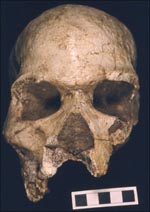Skull points to common ancestor
20 January 2007 | Story by Helen Swingler A mud-filled human skull found in an erosion channel by a dam construction worker near Hofmeyr, Eastern Cape, in 1954 has been dated to 36 000 years, corroborating genetic evidence that modern humans probably originated in sub-Saharan Africa and migrated at about this time to colonise the Old World. It also shows that Africans and Europeans looked very similar at that time.
Commenting on the skull's significance on the eve of a Science paper publication (Late Pleistocene Human Skull from Hofmeyr, South Africa, and Modern Human Origins, January 12, 2007), UCT's Professor Alan Morris (human biology) said: "The Hofmeyr skull gives us the first insights into the morphology of such a sub-Saharan population, which means the most recent common ancestor of all of us - wherever we come from."
Morris is part of an international team of scientists, lead by Frederick Grine of Stony Brook University, New York, conducting the study. A new dating technique, optically stimulated luminescence, developed by Oxford's Richard Bailey, finally allowed the team to place the skull in the human fossil record. Morris said that despite its generally rich paleontological heritage, sub-Saharan Africa is devoid of human fossils between 70 000and 15 000 years ago, leaving a critical gap in human evolutionary history. Because the Khoe-San are represented in the recent South African archaeological record and have an ancient heritage in the region, the Hofmeyr skull was expected to closely resemble them. Instead, this South African fossil has a very close affinity with the European Upper Paleolithic specimens and is quite distinct from recent sub-Saharan Africans, including the Khoe-San. The team's findings agree with the genetics-based Out of Africa theory, which predicts that humans like those that inhabited Eurasia in the Upper Paleolithic would have been found in sub-Saharan Africa around 36 000 years ago.
A mud-filled human skull found in an erosion channel by a dam construction worker near Hofmeyr, Eastern Cape, in 1954 has been dated to 36 000 years, corroborating genetic evidence that modern humans probably originated in sub-Saharan Africa and migrated at about this time to colonise the Old World. It also shows that Africans and Europeans looked very similar at that time.
Commenting on the skull's significance on the eve of a Science paper publication (Late Pleistocene Human Skull from Hofmeyr, South Africa, and Modern Human Origins, January 12, 2007), UCT's Professor Alan Morris (human biology) said: "The Hofmeyr skull gives us the first insights into the morphology of such a sub-Saharan population, which means the most recent common ancestor of all of us - wherever we come from."
Morris is part of an international team of scientists, lead by Frederick Grine of Stony Brook University, New York, conducting the study. A new dating technique, optically stimulated luminescence, developed by Oxford's Richard Bailey, finally allowed the team to place the skull in the human fossil record. Morris said that despite its generally rich paleontological heritage, sub-Saharan Africa is devoid of human fossils between 70 000and 15 000 years ago, leaving a critical gap in human evolutionary history. Because the Khoe-San are represented in the recent South African archaeological record and have an ancient heritage in the region, the Hofmeyr skull was expected to closely resemble them. Instead, this South African fossil has a very close affinity with the European Upper Paleolithic specimens and is quite distinct from recent sub-Saharan Africans, including the Khoe-San. The team's findings agree with the genetics-based Out of Africa theory, which predicts that humans like those that inhabited Eurasia in the Upper Paleolithic would have been found in sub-Saharan Africa around 36 000 years ago.
 This work is licensed under a Creative Commons Attribution-NoDerivatives 4.0 International License.
This work is licensed under a Creative Commons Attribution-NoDerivatives 4.0 International License.
Please view the republishing articles page for more information.
Related
Alderman Owen Kinahan (1955–2026)
06 Jan 2026
Celebrating UCT’s outstanding Thuthuka results
29 Dec 2025










